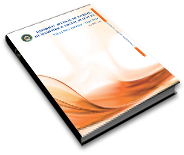การผลิตเทมเป้ถั่วเหลืองด้วยผงกล้าเชื้อ Rhizopus oligosporus TISTR 3098 ในระดับห้องปฏิบัติการ
Keywords:
เทมเป้, ถั่วเหลือง, ปริมาณโปรตีน, ผงกล้าเชื้อ, Rhizopus oligosporus, tempeh, soybean, protein content, starter powderAbstract
บทคัดย่อ
งานวิจัยนี้มีวัตถุประสงค์เพื่อผลิตเทมเป้ถั่วเหลืองด้วยผงกล้าเชื้อ Rhizopus oligosporus TISTR 3098 โดยวางแผนการทดลองแบบ Factorial in CRD ศึกษาผลของอุณหภูมิในการบ่ม (25, 30 และ 35 องศาเซลเซียส) และเวลาในการบ่ม (18, 24 และ 30 ชั่วโมง) ผลการศึกษาพบว่า อุณหภูมิและเวลาในการบ่มมีผลต่อลักษณะปรากฏของเทมเป้ถั่วเหลือง กระบวนการผลิตเทมเป้ถั่วเหลืองในระดับห้องปฏิบัติการทำได้โดยนำถั่วเหลืองพันธุ์เชียงใหม่ 60 มาแช่น้ำ 16 ชั่วโมง ลอกเยื่อหุ้มเมล็ดถั่วออก ต้มในน้ำเดือดนาน 40 นาที สะเด็ดน้ำให้แห้งในขณะที่ยังร้อน เติมผงกล้าเชื้อร้อยละ 5.0 โดยน้ำหนัก คลุกให้เข้ากัน ตักใส่ถุงพลาสติก (12 x 18 นิ้ว) ถุงละ 500 กรัม อัดให้เมล็ดถั่วเหลืองเป็นก้อนสี่เหลี่ยม ปิดปากถุง นำไปบ่มที่อุณหภูมิ 25 องศาเซลเซียส นาน 24 ชั่วโมง จะได้เทมเป้ถั่วเหลืองที่มีลักษณะปรากฏที่ดี พบเส้นใยสีขาวเจริญปกคลุมเมล็ดถั่วเหลือง ไม่พบการสร้างสปอร์สีดำและเมื่อหั่นเป็นชิ้นเมล็ดถั่วยังคงเกาะติดไม่หลุดออกจากกัน ผลการวิเคราะห์ค่าองค์ประกอบทางเคมีของเทมเป้ถั่วเหลือง (ผง) พบว่า มีค่าความชื้นร้อยละ 4.11 ไขมันร้อยละ 17.88 โปรตีนร้อยละ 43.17 เถ้าร้อยละ 3.79 เส้นใยหยาบร้อยละ 5.57 และคาร์โบไฮเดรต (รวมเส้นใยหยาบ) ร้อยละ 31.05 ผลการศึกษาแสดงว่า กระบวนการหมักมีผลให้ปริมาณโปรตีนในถั่วเหลืองมีค่าเพิ่มขึ้นเมื่อเปรียบเทียบกับถั่วเหลืองที่ไม่หมัก ดังนั้นจึงควรมีการศึกษาการนำถั่วเหลืองที่ผ่านกระบวนการหมักด้วยเชื้อรา R. oligosporus ไปพัฒนาเป็นผลิตภัณฑ์ใหม่ทดแทนเนื้อสัตว์ในอนาคตต่อไป
คำสำคัญ : เทมเป้ ถั่วเหลือง ปริมาณโปรตีน ผงกล้าเชื้อ Rhizopus oligosporus
Abstract
The objective of this study was to produce soybean tempeh with Rhizopus oligosporus TISTR 3098 starter powder. Factorial arrangement in completely randomized design (CRD) was used to assess the effects of temperature (25 oC 30 oC and 35oC) and incubation time (18 hr 24 hr and 48 hr). The results showed that temperature and incubation time affected soybean tempeh appearance. The production process of soybean tempeh in laboratory scale involved, soaking soybean (ChiangMai 60) for 16 hr, peeling membrane, cooking in water (100 oC) for 40 mins draining water, adding 5.0% (w/w) starter powder of R. oligosporus, mixing, putting 500 g of mixed soybean in plastic bag (12" x 18"), pelletizing, sealing plastic bag and incubating at 25oC for 24 hr. Soybean tempeh had a good appearance, the hyphal growth covered soybean, no black spores, and fermented soybean were still sticking when sliced. The chemical compositions of soybean tempeh (powder) were 4.11% moisture content, 17.88% fat, 43.17% protein, 3.79% ash, 5.57% crude fiber and 31.05% carbohydrate (include crude fiber). The result from this study showed that the fermentation process increased the protein content in comparison to soybean without fermented. Therefore the utilization of fermented soybean to replace meat protein for new products should be subjected to future study.
keywords : tempeh, soybean, protein content, starter powder, Rhizopus oligosporus
Downloads
How to Cite
Issue
Section
License
Each article is copyrighted © by its author(s) and is published under license from the author(s).










